Indigenous Conservation, National Parks, Nature Refuges, State Forests
Large hadroid land snails of south-eastern Queensland protected areas
Queensland has a sizeable number of large to very large land snails typically referred to as the hadroid snails, belonging to the family Camaenidae. A number of lineages are involved and this article features one such genus of Dark and Banded Snails from south-eastern Queensland whose species chiefly inhabit rainforest and dry vine thickets along the coastal plain and ranges and off-shore islands. All of these species have ranges that incorporate protected areas of one sort or another and because of their shell size are usually the subject of enquiry by parks staff managing these areas.
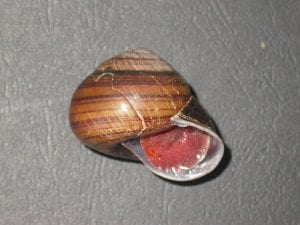
showing red mantle tissue
The genus of interest is the part of the red mantle lineage (Figuladra) as distinct from the black mantle lineage (Sphaerospira). The mantle is the tissue that is visible when the animal retracts into the shell. The mantle colour also extends to the foot and body of the snail to varying degrees with species of Figuladra having pinkish-grey animals. Figuladra comprises species distributed throughout the South East Queensland (SEQ) and Brigalow Belt South (BBS) bioregions. Figuladra also extends to the Central Mackay Coast (CMC) bioregion but the species are not featured in this article.
Figuladra species are readily distinguished by their pink to red mantles and pinkish-grey animals. Their distributions are often more complex than those of their dark lineage counterparts but again chiefly showing a preference for dry araucarian rainforest and vine thicket and in one instance open woodland.
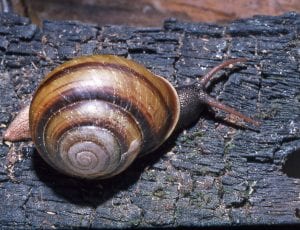
Occurring from from Mudlo National Park to State Forests around Maryborough is the Biggenden Banded Snail (Figuladra bayensis) whose shell becomes very large in the limestone habitat of Mt Biggenden. North of this species and centred around the Many Peaks and Dawes Ranges is the Goodnight Scrub Banded Snail (Figuladra reducta). To its north and centred around the Mt Morgan Range is the Mt Morgan Banded Snail (Figuladra narelleae). Out toward the coast in the Port Curtis/Gladstone area the Port Curtis Dark Snail (Figuladra lessoni = curtisiana) is found. This species has a brown shell with incipient banding. The Berserker Range Banded Snail (Figuladra appendiculata) is restricted to the Berserker Range, with Mt Archer being a key and accessible locality. North of Rockhampton, in Mt Etna Caves National Park and the greater Yeppoon area, lives the Yeppoon Varicoloured Snail (Figuladra aureedensis). This species is present in extremely large numbers in the limestones here where it has two shell colour morphs: a brown shell with a yellow patch on the base and yellow shell with numerous narrow brown bands.
While the above completes the inventory of described Figuladra species in SEQ, there are a number of yet to be described species also in the mix. These are currently undergoing study as part of a comprehensive revision of Figuladra.
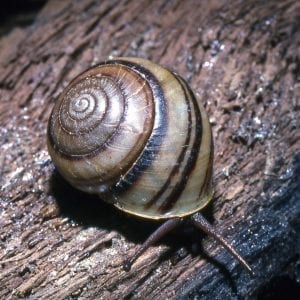
The woodland species is the Pale Banded Snail (Figuladra mattea) which is very common and widespread in the SEQ and BBS bioregions. Occurring from the Border Ranges to the Fitzroy River in the north and west to the Dawson River, this species lives in open woodland where there is no competition from any other hadroid species. Only on one occasion (at Mt Ox, via Theodore) has it been found monopolising vine thicket.
Land snails are a significant component of the terrestrial invertebrate fauna and play an important role in the decomposition process along with a host of other organisms. Their food is primarily decaying vegetation, fungus and other biofilm. The species outlined above are iconic but form only a very small part of Queensland’s estimated 900 or so species of land snails. Their presence is indicative of a healthy environment and potential biodiversity hotspots.
However, their greatest threat is habitat loss either through land clearing or fire. A fire that burnt scrub, including vine thicket, in the Mt Etna Caves National Park about two years ago, killed thousands of Yeppoon Varicoloured Snails.
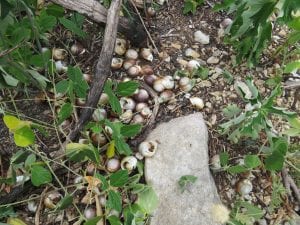


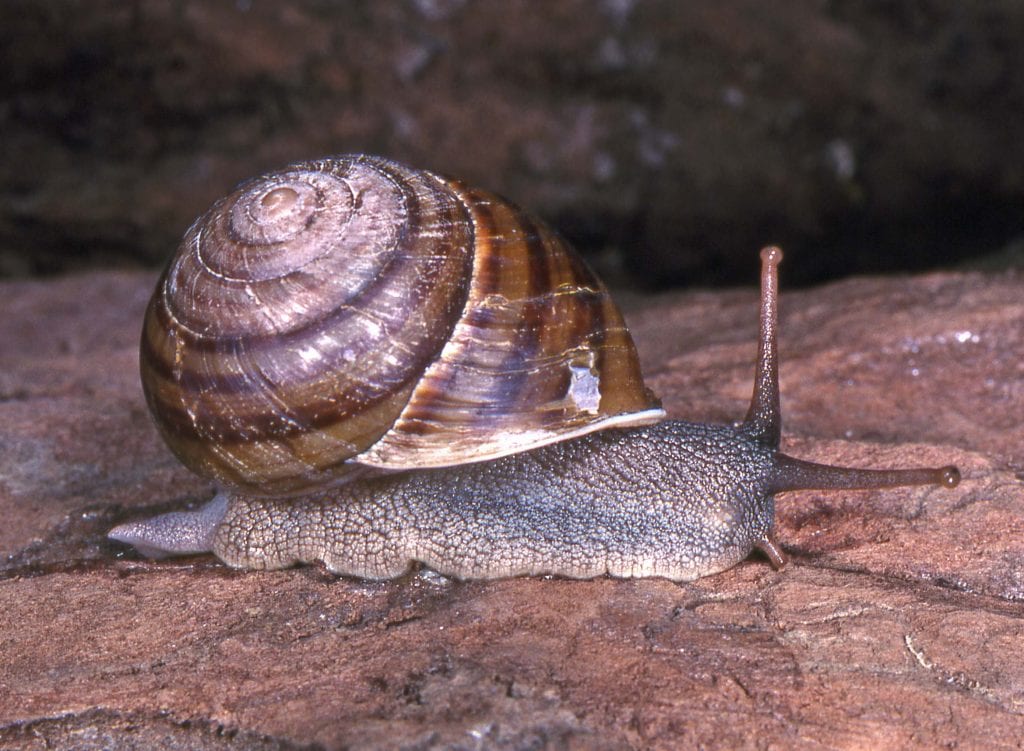
I have a number of what looks like Figuladra bayensis in my garden at Forestdale Brisbane, are they common in this area or do you think they have been introduced in pot plants.
Regards
Reg Illingworth
Hi Reg
Thank you for your query.
The below link shows the distribution of Figuladra bayensis from Queensland Museum records of sightings.
https://biocache.ala.org.au/occurrences/search?q=figuladra+bayensis#tab_mapView
From my research, I am unable to say if the snail is common in your area. I suggest you contact the Queensland Museum.
Janice
NPAQ volunteer